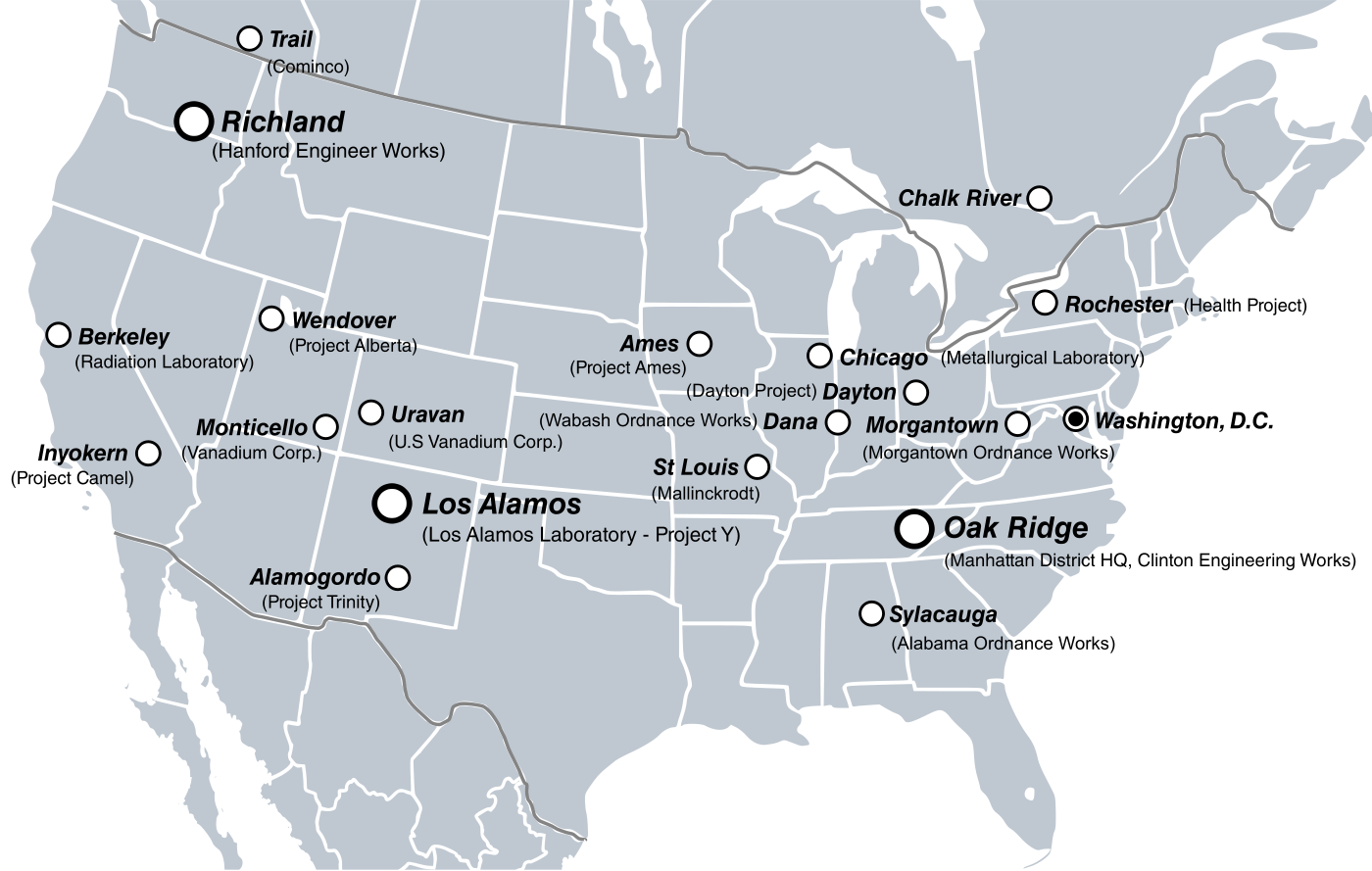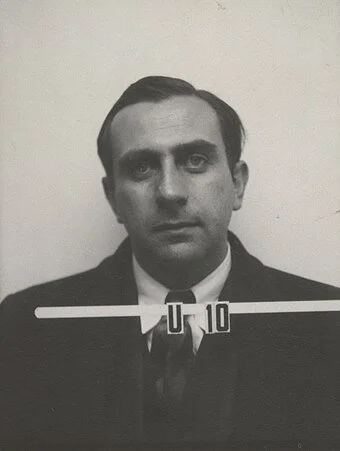
Llewellyn King: Memories of people I knew from the Manhattan Project; beautiful "Barbie'
Important sites in the Manhattan Project. Alamogordo is where the first atomic bomb was detonated, on July 16, 1945. The map would have been better if it had included the site of uranium 238 refining for the project by Metal Hydrides Inc., in Beverly, Mass.
Edward Teller’s (1908-2003) badge photo at the Manhattan Project’s Los Alamos, N.H., facility. Called “The Father of the Hydrogen Bomb,’’ he was seen as an inspiration for the eponymous scientist in Stanley Kubrick’s classic 1964 black comedy Dr. Strangelove.
WEST WARWICK, R.I.
I have been to the movies. I haven’t done that since before the COVID shutdown.
I went to see two huge movies that have each grossed $1 billion so far, and I enjoyed them enormously. They are, of course, Barbie and Oppenheimer.
I went to see Barbie because I thought I should know what people were discussing. I went to see Oppenheimer because, in a sense, I have skin in that game. I knew a few people who worked on the Manhattan Project, and two of them were characterized in the movie: Hans Bethe and Edward Teller, known as the father of the hydrogen bomb.
About Barbie: It is a fantasy romp filled with popular, real-life messages. I had to see how director Greta Gerwig would make an adult movie about a doll, albeit a storied one — with brilliant imagination is how.
Oppenheimer, by contrast, is a major cinematic work, a remarkable recapturing of history and character development on the screen. Christopher Nolan is a director at the top of his game. He deserves a comparison with Orson Welles and David Lean.
Across the board, it is a triumph, compelling and true to the facts and the personalities. The evocative recreation of Los Alamos as it must have been, of the tower from which the first nuclear device was detonated, rings true. I have crawled all over the nuclear-test site and spent many hours at Los Alamos, where I used to give an annual lecture on energy or the relationship of humans to science.
In November 1975, Bethe and another veteran of the Manhattan Project, Ralph Lapp, and I put together a panel of 24 Nobel laureates (including Bethe) to defend civilian nuclear power. We got them all together on a stage at the National Press Club, in Washington. I had hoped that it would be a seminal event, ending some of the nonsense being spread about nuclear radiation.
Ralph Nader took up arms against us and assembled 36 Nobel laureates who were cool to nuclear. Ours were physicists, engineers and mathematicians who had a vast understanding of nuclear and endorsed it enthusiastically.
We didn’t win. Bethe, as I recall, was philosophical about being trounced.
I first met Teller in Geneva. I was to introduce him at a conference, and we had breakfast together. He seemed distracted and confused. But he was in top form when he spoke.
Later, I got to know him better. He gave a series of speeches for conferences I had organized on the Strategic Defense Initiative — colloquially known as Star Wars. He often sat slumped in his chair, clutching his enormous walking stick. But he stood erect on the podium, arguing vigorously the case for Ronald Reagan’s program.
The Oppenheimer movie reminded me of two institutions I covered intensely as a reporter: the Atomic Energy Commission (AEC) and its congressional overseer, the Joint Committee on Atomic Energy.
The committee was supposed to check the AEC. The AEC was a tool of the powerful and wildly pro-nuclear committee — the only joint committee empowered to introduce legislation in both houses of Congress. The reality of that partnership was that the committee proposed and the AEC disposed.
The movie is extraordinary in capturing the workings of Congress and how a nod or a smile can put great events in motion.
This understanding of the nuances and mores of Washington, and particularly the arcane theatricality of the congressional hearings, is accurate in ways seldom captured on film. This is more surprising given that the director is an Englishman who lives a very private life in Los Angeles.
I leave it to sociologists to ponder how two movies as different as Barbie and Oppenheimer could open simultaneously, becoming huge hits. If you see these movies, especially Oppenheimer, see them in the theater. They deserve that big-screen and wraparound-sound environment.
On Twitter: @llewellynking2
Llewellyn King is executive producer and host of White House Chronicle, on PBS.
White House Chronicle
Sarah Anderson: Of Mattel's vast pay gap and a model Iowa employer
This is the first Barbie, introduced by Mattel in 1959.
Via OtherWords.org
Mattel executives say they’re worried about girls developing “self-limiting beliefs,” resulting in a “dream gap” with boys.
So the giant toymaker rolled out an extensive line of “Career Dolls,” including Barbie pilots, firefighters, and robotic engineers, to inspire its young patrons. But there’s one career you won’t find in this line: the typical working woman on the Mattel payroll.
That median employee would be an Indonesian factory worker who earned just $5,489 in 2018. By contrast, Mattel CEO Ynon Kreiz took home $18.7 million — 3,408 times more than his line workers.
Talk about a dream gap.
Mattel is just one of 50 U.S. corporations that paid their CEO more than 1,000 times more than their typical employee last year, according to a new Institute for Policy Studies report.
This doesn’t just impact foreign factory workers. Starbucks, Gap, Chipotle, Foot Locker, and Williams-Sonoma are all examples of companies where U.S.-based workers would have to labor for a full millennium to earn as much as their CEO did in one year.
No single mortal adds more than 1,000 times as much value to a company as any other employee. Corporate leaders seem to know this, because they avoid media questions about their pay gaps like the plague.
Recently, a Marketwatch reporter asked 11 companies to comment on their extremely wide pay disparities. Only three were brave enough to respond, and their excuses were embarrassingly lame.
A Mattel spokesperson pointed out that $5 million of the CEO’s $18.7 million take was a hiring bonus. Without that one-time payout, Mattel’s pay gap would’ve been a “mere” 2,496 to 1.
Chipotle’s PR department insisted that their CEO’s $33.5 million paycheck was perfectly in line with “his peer group.” All the other kids are doing it!
Walmart’s flack pivoted away from the CEO’s $23.6 million paycheck to boast about the company’s recently increased starting pay — a whopping $11 per hour. Despite this bounty, Walmart workers still somehow take home 1,076 times less than their CEO.
These gaps weren’t always the norm. Back in the 1950s, the ratio between CEO and typical worker pay was around 20 to 1.
In a recent op-ed in USA Today, 98-year-old entrepreneur and former Iowa congressman Berkley Bedell described the philosophy that guided him and many other business leaders back in that era.
Businesses “had to have a purpose grander than just piling up profits,” he wrote, and “I tried to live my business life from that perspective.”
As the CEO of the fishing tackle manufacturer Berkley, Bedell started a profit-sharing program that distributed 20 percent of the company’s earnings to workers. An employee recreation fund fostered team spirit and gave everyone on his payroll the chance to go on fishing trips or to ball games.
“I never paid myself more than four or five times what my employees were making,” he recalls. “I lived like my friends in my hometown of Spirit Lake, Iowa. I drove an older car, served as a Scoutmaster, and resided in a modest home. I had a good life.”
Yet today’s overpaid CEOs are unlikely to start sharing that good life — and the wealth that finances it — more equitably without public policies to prod them in this direction.
Some of Bedell’s proposals include putting workers on corporate boards and giving companies with modest pay gaps preferential treatment, such as lower tax rates and a leg up in government contracting.
These kinds of policies recognize the dignity and value in the labor of all employees — not just the guy in the corner office.
Sarah Anderson is a co-editor of Inequality.org at the Institute for Policy Studies and a co-author of the IPS report “Executive Excess: Making Corporations Pay for Big Pay Gaps’’.



